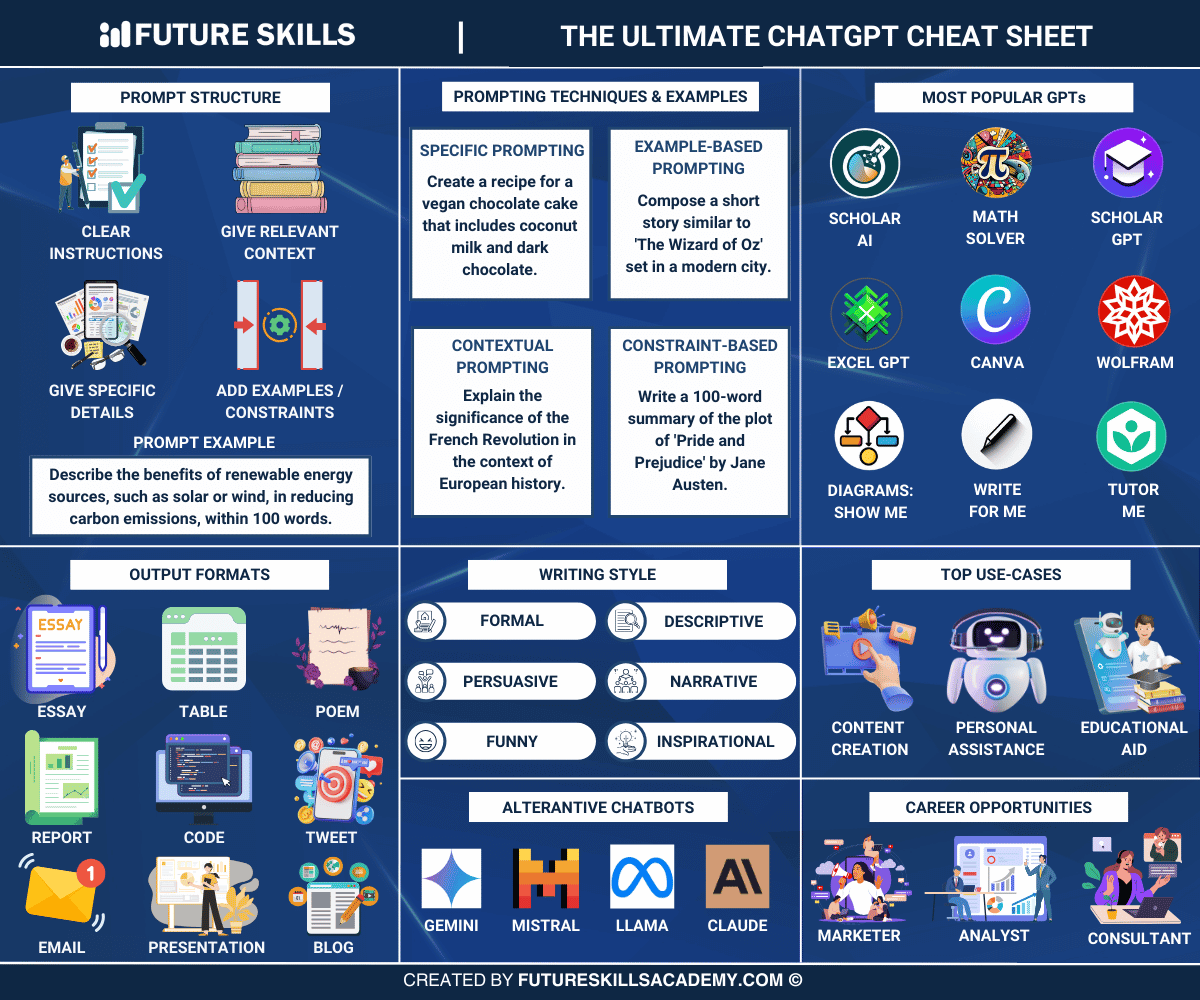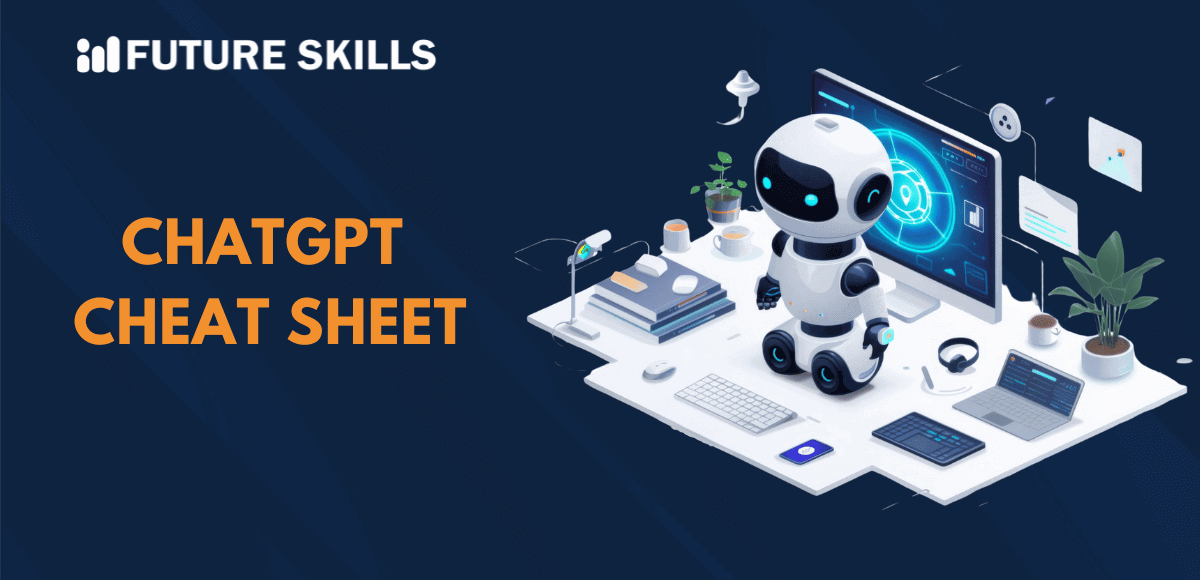ChatGPT has proved that AI can be versatile and accessible to everyone. The numerous applications of ChatGPT have created new avenues for boosting creativity, problem-solving capabilities, and learning. As the curiosity to learn ChatGPT increases, the demand for comprehensive training resources on ChatGPT has been growing. You can use a ChatGPT cheat sheet to learn the best ways to harness the potential of generative AI for different tasks.
As a beginner, you may assume that using ChatGPT only involves communicating with it by using textual instructions. A ChatGPT cheat sheet explained for beginners could make a huge difference in approaches you follow to use ChatGPT. Cheat sheets for ChatGPT focus on general mistakes in creating ChatGPT prompts and techniques to refine prompts for better results. Let us explore a detailed ChatGPT cheat sheet with examples of the most productive prompts for business, writing, and coding.
Learn how to make the most of ChatGPT and become a ChatGPT expert with our leading Certified ChatGPT Professional (CCGP)™ Program.
Why Do You Need a ChatGPT Cheat Sheet?

The revolutionary applications of ChatGPT have invited attention towards the importance of prompts to achieve desired goals in various tasks. You might wonder about the relevance of queries like “What is the ChatGPT cheat sheet?” for anyone interested in using ChatGPT. It is important to remember that ChatGPT may understand instructions in natural language but not like humans. ChatGPT works with the help of LLMs that transform instructions in natural language to numerical data or tokens to facilitate easier processing.
The ChatGPT cheat sheet is an essential requirement for refining prompts to help users tap into the potential of AI. Cheat sheets can serve as a creative brief for improving the ability of users to extract articulate and nuanced responses from ChatGPT. You can use ChatGPT cheat sheets for guidance on avoiding common mistakes in prompting.
Some of the most notable prompting mistakes in a ChatGPT cheat sheet for writing prompts include the following.
- Creating prompts with ambiguous or vague instructions can lead to difficulties for ChatGPT in understanding the nature of your requests.
- Prompts that feature leading questions are likely to restrict the ability of ChatGPT to generate diverse or creative responses.
ChatGPT cheat sheets help you avoid the mistake of providing inappropriate context in your prompts. The context determines the environment in which ChatGPT would work to answer your queries.
Another common mistake in creating prompts is the use of long prompts that can overshadow the actual instruction. Even if ChatGPT has impressive processing capabilities, it has certain limits in terms of the instructions it can handle.
What are the Fundamental Elements of a Prompt?
The next crucial aspect in a ChatGPT cheat sheet explained for beginners would shed light on the fundamental elements of prompts. If you want to get the right output from ChatGPT, then you should know how to refine different elements of a prompt. The important components in a prompt include the instruction, context, input data, output format and restrictions.
The instruction in a prompt tells what you want to achieve from AI and context helps in narrowing down the focus of AI to the concerned problem. Input data in a prompt specifies the information that serves as the foundation of its response. The output indicator or format is a crucial element in ChatGPT cheat sheet for coding for guiding the AI model to generate responses in a specific style. Constraints are also important for prompt design as they provide specific requirements or limitations for the responses by ChatGPT.
How Can You Get the Best Results from ChatGPT Prompts?
The quality of prompts play a major role in determining the effectiveness and accuracy of responses from AI models such as ChatGPT. You must create prompts with special attention to detail so that ChatGPT can fully understand your requirements and generate accurate responses. Here is an overview of the most effective techniques to refine prompts for different tasks.
-
Provide a Clear Definition of Expected Outputs
ChatGPT is a treasure trove of information and could provide multiple answers for your instructions. In some cases, the AI chatbot can generate outputs in incomprehensible formats. A ChatGPT cheat sheet for business tasks can help you exercise control over the output generated by ChatGPT. You can specify the format or style of ChatGPT output to offer clear directions for customizing the responses according to your existing needs.
-
Establish the Context for ChatGPT
Generic prompts fail in providing the right direction or determining the focus of ChatGPT in addressing the concerned task. Without any clear instructions, ChatGPT is more likely to make different assumptions according to the instructions. You can establish the most effective context for ChatGPT prompts by using background information, previous examples or target audience.
-
Examples Can Work Wonders
The most effective recommendation in a ChatGPT cheat sheet for writing tasks would be the use of examples. You can use specific examples or references in prompts to show ChatGPT how it should generate responses tailored to your needs. ChatGPT prompts with examples of sample emails can help the AI chatbot respond effectively to emails.
-
Labeling Prompts for Accurate Results
Simple prompts can be processed effectively by ChatGPT as they include only a few lines of instructions. On the other hand, processing complex prompts with different elements can create difficulties for ChatGPT. You can use labeling for different sections of complex prompts to help ChatGPT recognize different elements of the prompt.
-
Define the Right Constraints in Prompts
Constraints are the most important component of ChatGPT prompts as they can help in generating results that match your expectations. AI chatbots such as ChatGPT can produce any type of content in response to your instructions without limitations. You can establish constraints, such as a specific number of words in the response, thereby ensuring that you get the desired results.
Examples of Applications of ChatGPT Prompts for Different Use Cases
The most prominent applications of ChatGPT are evident in the fields of business, coding and writing or creative tasks. The most important highlight in responses to “What is the ChatGPT cheat sheet?” draws attention towards the examples of ChatGPT prompts for different tasks in these domains. Here is a glimpse of how you can use different ChatGPT prompt examples for common tasks.
-
ChatGPT Prompt Examples for Writing
The foremost and most popular use case of ChatGPT in any cheat sheet is writing. ChatGPT is a powerful tool for creative tasks such as copywriting, crafting emails and writing blogs, essays or articles. The examples in a ChatGPT cheat sheet explained for writing tasks can help in addressing different types of writing tasks. Here are some of the top examples of ChatGPT prompts that you can use for writing tasks.
Write an informative blog post on why people should vote in a democracy. Explain why voting is a fundamental right and how people can exercise their right to vote. Can you complete the following sentence? [Your sentence] Create a social media post for a CRM software highlighting its user interface and features. Reply to this email [Your email] with a friendly tone.
You can explore a detailed ChatGPT cheat sheet for writing with more examples for other tasks such as creating academic content. ChatGPT prompts can help in improving essays or resume summaries of people.
-
ChatGPT Prompt Examples for Coding
The next most common use case of ChatGPT is coding. As a matter of fact, a ChatGPT cheat sheet for coding can also help you use ChatGPT prompts for data science tasks. Here is an overview of the examples of ChatGPT prompts for coding tasks.
How to merge two datasets in Python? Create a roadmap to learn [programming language]. I want to create [type of website]. Can you generate the HTML code for the website? Can you optimize the Python code? [Insert Python code]
-
ChatGPT Prompt Examples for Business Tasks
The popularity of ChatGPT has increased due to its adoption in the business landscape for different tasks. You can explore a ChatGPT cheat sheet for business tasks to find prompts for improving productivity. Here are some of the top ChatGPT prompt examples you can use for business tasks.
Create an agenda for our annual business meeting. Generate new ideas for a blog post about our latest product launch [insert product description]. Give me some recommendations on increasing click-through rates for our email marketing campaign. Recommend the target audience on Instagram for an ad campaign on a new line of beauty products.
Familiarize yourself with how AI boosts businesses and saves a lot of time and money with our new AI for Business course.
Final Words
The positive implications of ChatGPT for writing, coding and business tasks have revolutionized the AI landscape. You must learn ChatGPT best practices with the help of a cheat sheet to familiarize with essential tricks. The cheat sheet can help you learn how to avoid your mistakes in creation of prompts. ChatGPT cheat sheets can also help users refine their prompts to achieve desired results.
An effective cheat sheet provides a glimpse of the types of prompts you need to make the most of ChatGPT. Cheat sheets can serve as valuable tools for improving your productivity with AI chatbots such as ChatGPT. The examples of prompts in a ChatGPT cheat sheet offer an effective resource for practical understanding of ChatGPT capabilities. Discover the most comprehensive guides on ChatGPT and harness its true potential now.
Enroll in our highly trusted ChatGPT Certification course and get the opportunity to master ChatGPT skills to grow further in your professional workspace.






